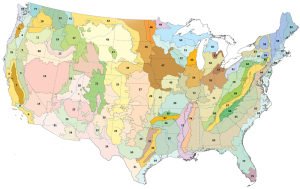Our 20-or-so-hour road trip from Ithaca to Orlando (not counting stops) took us through several different ecoregions: 11 of them, according to the EPA classification (see map below). We also went through several parts of the Appalachian Mountains, from the northern Plateau, through the Ridge and Valley Provience in PA, along the Blue Ridge Mountains, down the Piedmont, along the eastern Coastal Plain, and finally onto the Great Sandbar (Florida).
The Appalachian range is a venerable, ~480 million year old mountain chain. However, with great age comes great erosion. I like my mountains dramatic, rising abruptly from the plain (or ocean), not so much a series of lumpy big hills. Although living in Florida, I shouldn’t complain. But there was another aspect to the scenery that was less than thrilling to gaze upon for hour upon hour: the trees.
While this is oversimplifying, most of the eastern U.S. used to be covered with hardwood forest. While most of that forest was logged out and used for farmland starting in the 1700s, large portions of it are now reverting to forest because agricultural operations have been moving farther west. This means that secondary forests are springing up, though these patches are broken up by remaining farmland and urbanized areas.
While there are some fairly big differences between the ecoregions we drove through, they mainly fall into one large category: eastern temperate forests. So guess what most of the scenery from New York to Florida involves? Trees. Trees on hills, trees on plains, some farms surrounded by trees, and cities and suburbs with no trees. The occasional stream or river, overhung by …trees. And mostly broadleaf trees: oaks, elms, maples, etc. Lovely species all, but not terribly exciting to look at after about hour number 10.
Most of my distance driving has been done either in the plains, western U.S., or on Hawaii (assuming 2 hours at a time counts for distance…). Granted, the plains are none too thrilling in places (corn or soybeans?). But at least you can see for long distances- none of this broadleaf brushy stuff blocking your view of everything more than 10 feet from the road (I’m talking about you, I-26 through South Carolina). No distant mountains to gauge your progress against, very few dramatic changes in elevation, and always this leafy temperate forest underbrush. We were glad to get back to Florida, where even though half of what you see on I-95 is pines and palmettos, there’s a lot of short-distance variation- saw palmetto, pine flatwoods, prairie, and marsh, all determined by very subtle elevation and moisture differences.
